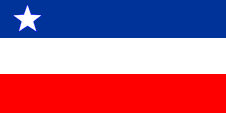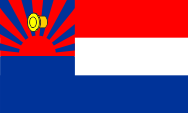Karenland |
|
|
|
| Übersicht – Contents: | |
Diese Seite ist Teil des Projektes
Karenland |
|
|
|
| Übersicht – Contents: | |
Flaggen – Flags: |
|
 |
Flagge des Karen-Staats |
 |
Flagge von Kawthoolei (KNU Partei) – flag of Kawthoolei (KNU Party), Quelle/Source, nach/by: burmalink.org, Die Welt der Flaggen |
Bedeutung/Ursprung der Flagge – Meaning/Origin of the Flag: |
|
| Die Flagge von Karenland, als Provinz von Burma (Myanmar) zeigt die Farben Blau, Weiß und Rot in waagerechten Streifen und in der Oberecke einen weißen Stern. Letzerer steht sicherlich für Burma. | The flag of Kayin State, as a province of Burma (Myanmar) shows the colours blue, white and red in horizontal stripes and in the upper corner a white Star. The latter certainly stands for Burma. |
| Die Flagge von Kawthoolei, der unabhängige Karen-Staat, für den die Karen National Union seit 1948 kämpft, zeigt die Farben Rot, Weiß und Blau in waagerechten Streifen und in der Oberecke eine stilisierte aufgehende Sonne und eine goldene Trommel. | The flag of Kawthoolei, the independent state of the Karen-Nation, for which the Karen National Union has fought since 1948, shows the colours red, white and blue in horizontal stripes and in the upper corner a stylized rising sun and a golden drum. |
| Über den Ursprung und die Bedeutung der Farben liegen hier keine Erkenntnisse vor. Es kann jedoch Folgendes vermutet werden: Die Gründung des unabhängigen Karenland fällt mit dem antijapanischen Widerstand und dem Ende des Zweiten Weltkriegs zusammen, so dass die Karen die Farbkomination Blau-Weiß-Rot schon während des Krieges gewählt haben könnten, um ihre Zugehörigkeit zu den Alliierten deutlich zu machen, indem sie deren Farben verwenden. Ein ähnlicher Prozess hat sich im Jahre 1917 schon einmal im Nachbarland Thailand vollzogen. |
About the origin and the meaning of the flag is here nothing known. There
could be made the following speculation: The establishment of the independent Kayin State coincides with the anti-Japanese resistance and the end of the Second World War, so that the Karen could had elected the color's sequence of blue-white-red already during the war, to express their affiliation to the allies by using their colours. A similar process was once already performed in the year 1917 in the neighbouring country Thailand. |
| Quelle/Source: Volker Preuß | |
| interaktive Landkarte – interactive Map: |
|
| Quelle/Source: Map is Freeware, University of Texas Libraries, modyfied by: Volker Preuß |
| Zahlen und Fakten – Numbers and Facts: | |
|
|
|
|
|
|
|
|
|
|
|
|
|
|
|
|
|
|
Geschichte: |
| Die Karen (KaRyang), ein sinotibetisches Volk, widersetzten sich schon zur Zeit der britischen Kolonisierung den Machtambitionen der Birmesen, auch mit britischer Hilfe. Nach der Unterwerfung durch Großbritannien (1886) wurden die Karen von den Briten innerhalb deren Kolonialarmee vorzugsweise gegen die birmesische "Befreiungsarmee" eingesetzt. Während der japanischen Besetzung im 2. Weltkrieg kämpften die Karen unter der Führung britischer Offiziere gegen die Japaner. Nach dem Abzug der Japaner sahen die Karen ihre Chance und erklärten sich für im Jahre 1947 für unabhängig. In Kämpfen mit birmesischen Milizen, in denen die Karen durch die Briten unterstützt wurden, konnten sie sich bis 1948 behaupten. Die Birmesen schlossen den Karenstaat 1948 als halbautonomen Staat ihrem im gleichen Jahr von Großbritannien unabhängig gewordenen Staat Birma an. Zwischen 1951 und 1973 trug Karenland den Namen Kawthoolei. Die Karen kämpften weiter für einen von Birma unabhängigen Staat, und mussten 1950 schwere militärische Rückschläge hinnehmen und unterzeichenten 1964 ein Abkommen mit den Birmesen zur Einstellung der Kampfhandlungen. Partisanen der Karen setzten jedoch in den Bergregionen, vor allem an der Grenze zu Thailand, ihren Kampf fort, vor allem gegen den 1962 gebildeten "Recht und Gesetz Wiederherstellungsrat" (SLORC), ein Terrorinstrument der Birmesen. Im Jahre 1976 beschloss der SLORC ein Umsiedlungsprogramm. Die Dorfbevölkerung der Karen hatte sich auf schnellstem Wege zu den angegebenen Umsiedlungsstellen zu begeben, wo sie ohne genügend Nahrung und medizinische Versorgung verblieben. 1988 erfolgten Protestkundgebungen gegen die 26-jährige SLORC-Militärherrschaft. Tausende von protestierenden Karen wurden ermordet, und die Karen-Reservate unter direkte Militärherrschaft gestellt. Bis Mitte der 90-er Jahre konnten Partisanen der Karen erhebliche Geländegewinne erzielen. Ein weiteres Vordringen der Karen wurde durch eine Offensive der Regierungstruppen verhindert. 1995 war sich die "Karen National Partei" mit der SLORC über einen Waffenstillstand einig geworden, der den seit 48 Jahren andauernden Krieg beenden sollte. Dieser Waffenstillstand hielt nicht lange. Die Brutalität und systematischen Menschenrechtsverletzungen durch die SLORC sind alle gut nachgewiesen und dokumentiert. Die Karen sind und bleiben ökonomisch und physisch unterdrückt. Im Amnesty - International - Report von 1997 wurden die Karen (neben den Shan und Mon) als meistverfolgte Ethnie Burmas dargestellt. Es wird geschätzt, dass allein während der Zwangsumsiedlung des Jahres 1996, 20.000 bis 30.000 Karen alles verloren haben, Häuser, Land und Habseligkeiten. Die meisten von ihnen endeten in staatlichen Umsiedlungslagern, während sich 7.000 andere nach Thailand retten konnten. |
| Quelle/Source: UNPO |
History: |
| The Karen (KaRyang, Kayin), a sino-tibetian people, opposed already in the times of the British colonization the power's ambitions of the Burmese, even with British support. After the subjection by United Kingdom (1886) the Karen were used by the British within their colonial army preferably against the Burmese "liberation army". During the Japanese occupation in the 2nd World War fought the Karen under the guidance of British military officers against the Japanese. After the withdrawal of the Japanese the Karen saw their chance and declared themselves for independent in the year 1947. In the struggles with Burmese militias, in which the Karen were supported by the British, they could contend until 1948. The Burmese annexed the Karen State in 1948 as a semi autonomous state to their State of Birma, which became independent from United Kingdom in the same year. Between 1951 and 1973 Kayin State carryed the name Kawthoolei. The Karen continued the struggle for a from Burma independent state, and had to accept in 1950 heavy military setbacks and signed in 1964 an agreement with the Burmese to stop the fightings. Partisans of the Karen however continued their fight in the mountains region, especially near the frontier to Thailand, and against the in 1962 established "Right and Law Reconstruction Council" (SLORC), a Burmese instrument of terror. In the year 1976 the SLORC determined a program for resettlement. The Karen people in the country had to go so quick as they could to the stated resettlement locations, where they stayed without enough food and medical support. In 1988 followed protest rallies against the 26 years of the SLORC military rule. Thousands of protesting Karen get murdered, and the Karen reserves came under direct military control. Until the middle of the nineties the partisans of the Karen could achieve substantial territorial gains. A further advance of the Karen was stopped by an attack of the governmental troops. In 1995 the "Karen National Partei" and the SLORC came to an agreement about an armistice, which schould finish the since 48 years enduring war. This armistice had not a long live. The brutality and systematical injuries against the human rights by the SLORC are all well proven and documented. The Karen are and remain economical and physical oppressed. In the Amnesty - International - Report from 1997 the Karen (in addition to the Shan and Mon) are represented as the mostly haunted people of Birma. It is estimated that only during the forced resettlements of the year 1996, 20.000 to 30.000 Karen lost all, houses, land and meagre personal possessions. The bigest part of them end in resettlement camps of the state, while 7.000 escaped to Thailand. |
| Quelle/Source: UNPO |